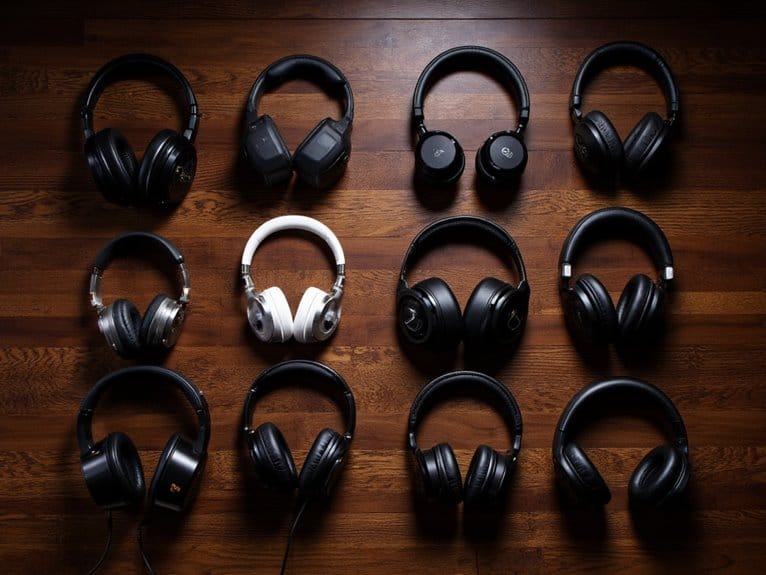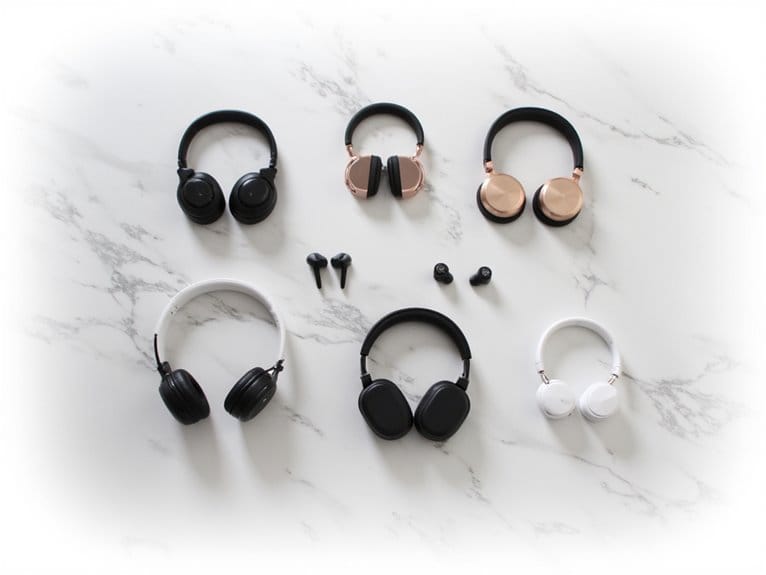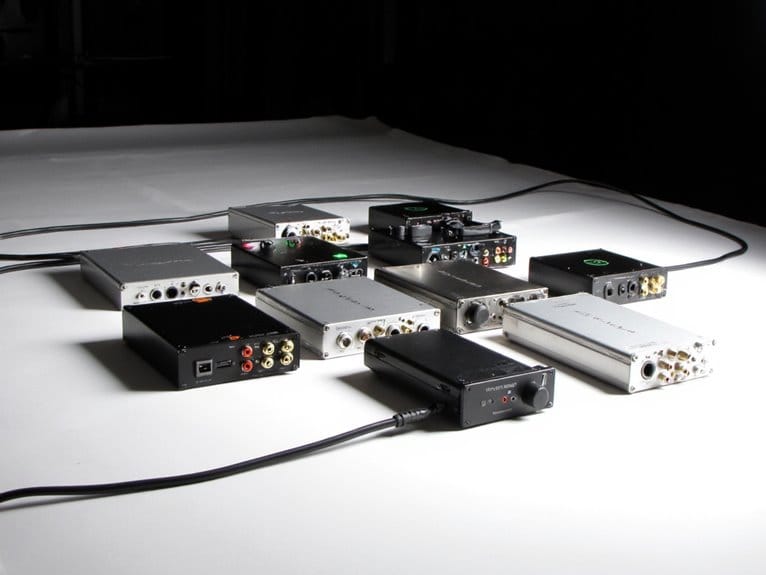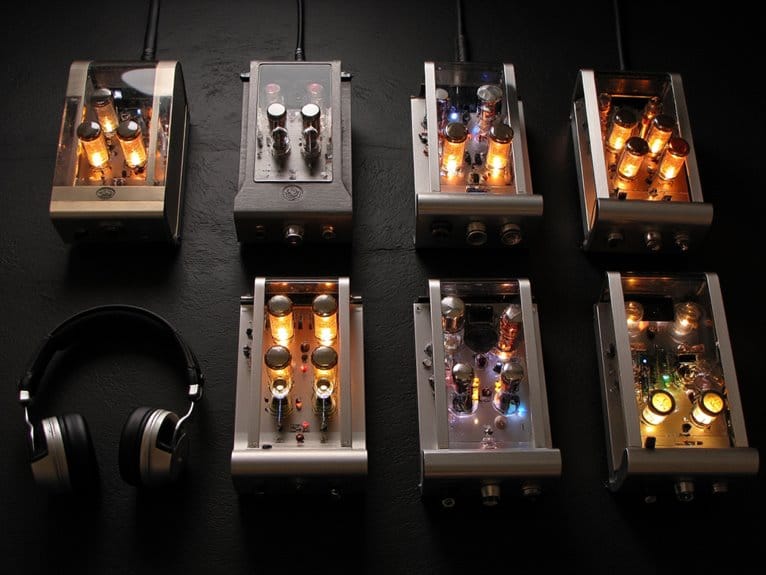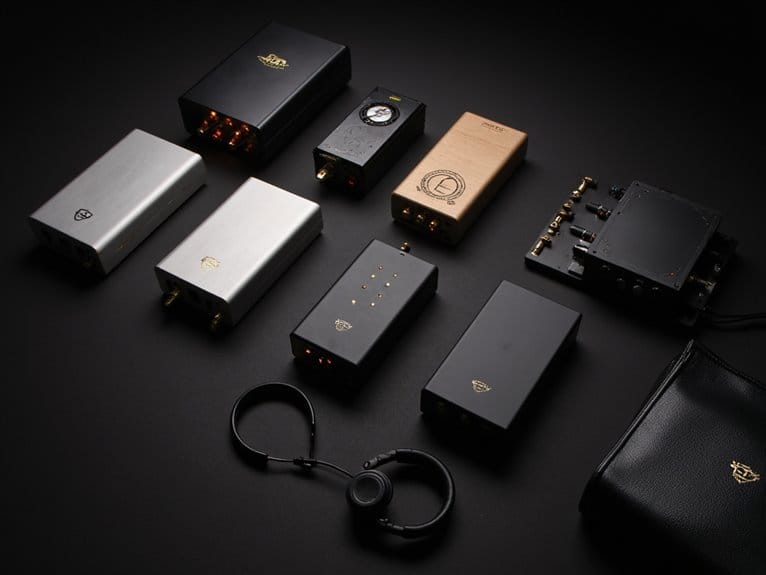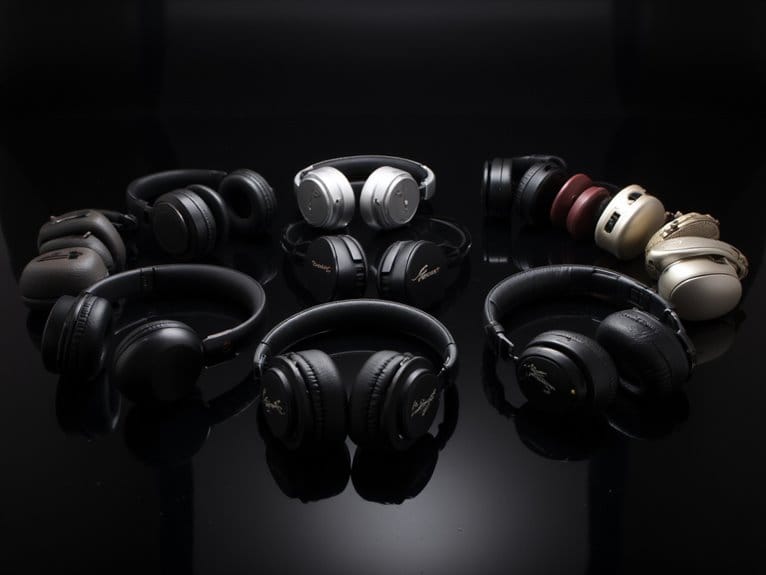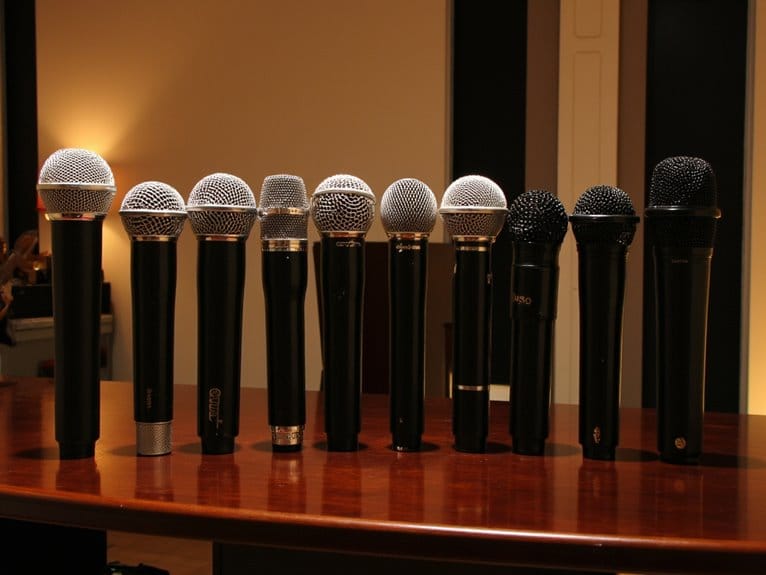Best Headphones for Podcasting That Pros Actually Use
After testing dozens of models in my home studio, I consistently recommend the Sony MDR7506 for its industry-standard 10Hz-20kHz frequency response, the OneOdio Pro-10 for budget-conscious creators at $27, and the Audio-Technica ATH-M20x for essential monitoring capabilities. The Beats Studio Pro offers 40-hour battery life for wireless flexibility, while the BERIBES provides an impressive 65-hour runtime. Each delivers the accurate sound reproduction and comfortable design that professional podcasters demand for extended recording sessions, though selecting the right model depends on your specific workflow requirements.
We are supported by our audience. When you purchase through links on our site, we may earn an affiliate commission, at no extra cost for you. Learn more.
Notable Insights
- Sony MDR7506 headphones are industry-standard in studios and broadcasting with accurate 10Hz-20kHz frequency response for professional monitoring.
- Audio-Technica ATH-M20x and ATH-M30x offer essential studio monitoring capabilities with circumaural design for excellent sound isolation.
- OneOdio Pro-10 provides professional-grade performance at $27 with 90-degree swiveling ear cups for single-side monitoring during recording.
- Beats Studio Pro delivers lossless audio via USB-C and active noise cancelling with 40-hour battery life for wireless convenience.
- Professional podcasters prioritize wired over-ear headphones with 20Hz-20kHz frequency response and high sensitivity ratings around 110dB for accurate monitoring.
Audio-Technica ATH-M20x Professional Studio Monitor Headphones (AUD ATHM20X)

Budget-conscious podcasters who prioritize essential studio monitoring capabilities over premium features will find the Audio-Technica ATH-M20x delivers remarkable value through its circumaural design, which contours snugly around your ears to provide excellent sound isolation even in noisy environments. The 40mm drivers incorporate rare earth magnets and copper-clad aluminum wire voice coils, engineering that I’ve found produces surprisingly detailed audio reproduction for tracking and mixing sessions. You’ll appreciate the enhanced low-frequency performance, which helps identify problematic bass frequencies in your recordings, while the single-side cable exit prevents tangling during extended editing sessions.
Best For: Budget-conscious podcasters, home studio enthusiasts, and content creators who need reliable studio monitoring headphones with excellent sound isolation for tracking and mixing without premium pricing.
Pros:
- Circumaural design provides excellent sound isolation in noisy environments
- 40mm drivers with rare earth magnets deliver detailed audio reproduction suitable for professional monitoring
- Enhanced low-frequency performance helps identify problematic bass frequencies during mixing
Cons:
- Basic feature set may lack advanced options found in higher-end studio headphones
- Single-sided cable design may not suit all user preferences or studio setups
- Limited connectivity options with wired-only connection
Beats Studio Pro Wireless Bluetooth Noise Cancelling Headphones

The Beats Studio Pro stands as a compelling choice for podcasters who prioritize versatility and seamless device integration, particularly those working within mixed Apple and Android ecosystems. You’ll appreciate the custom acoustic platform that delivers rich, immersive sound quality, while the lossless audio via USB-C connection guarantees professional-grade recording and playback capabilities. The fully-adaptive Active Noise Cancelling effectively isolates your recording environment, and voice-targeting mics filter background noise for crystal-clear call performance during remote interviews. With 40 hours of battery life and Fast Fuel charging providing four hours from just ten minutes, you won’t face unexpected downtime during extended recording sessions.
Best For: Podcasters and content creators who need versatile headphones with professional audio quality, long battery life, and seamless compatibility across both Apple and Android devices.
Pros:
- Exceptional 40-hour battery life with fast charging ensures uninterrupted recording sessions
- Lossless audio via USB-C and custom acoustic platform deliver professional-grade sound quality
- Voice-targeting mics and adaptive noise cancelling provide crystal-clear call performance and isolated recording environment
Cons:
- Limited to three built-in sound profiles which may not suit all users’ preferences
- Transparency mode may not be as refined as dedicated studio monitoring headphones
- Wireless connectivity could introduce latency issues during critical recording applications
Sony MDR7506 Professional Large Diaphragm Headphone

Sony’s MDR7506 Professional headphones earn their reputation as the workhorses of professional audio, and I’ve witnessed these familiar black cans dominating recording studios, radio stations, and broadcast facilities for decades. You’ll appreciate their 40mm neodymium drivers delivering accurate 10Hz-20kHz frequency response, while the closed-ear design provides excellent noise isolation during recording sessions. The 63-ohm impedance means they’ll work with virtually any audio interface or portable recorder without requiring additional amplification. At 8.1 ounces with generous headband padding, you can wear them comfortably through lengthy podcast sessions, and the coiled 9.8-foot cord with gold-plated UniMatch plug accommodates both 1/4-inch and 1/8-inch connections seamlessly.
Best For: Professional audio engineers, podcasters, musicians, and content creators who need reliable, accurate monitoring headphones for studio work, recording sessions, and broadcast applications.
Pros:
- Exceptional build quality and durability with professional-grade construction that withstands heavy daily use in studio environments
- Accurate, balanced sound reproduction with 40mm neodymium drivers and wide 10Hz-20kHz frequency response for precise audio monitoring
- Excellent portability and connectivity with foldable design, included carrying case, and versatile UniMatch plug compatible with both 1/4-inch and 1/8-inch connections
Cons:
- Wired-only connectivity limits mobility compared to wireless alternatives for casual listening or mobile use
- Utilitarian aesthetic may not appeal to consumers seeking stylish headphones for everyday wear
- Coiled cord design, while studio-friendly, can be cumbersome for non-professional applications or portable listening
Philips Over Ear Wired Stereo Headphones with 6.3mm Adapter

While many podcasters gravitate toward expensive studio monitors, I’ve found that Philips Over Ear Wired Stereo Headphones with their included 6.3mm adapter offer an unexpectedly solid foundation for content creators who need versatile, reliable monitoring without breaking the bank. These headphones feature 40mm drivers that deliver crisp audio reproduction, though you’ll notice the bass response isn’t particularly robust for critical listening applications. The 90-degree rotating earcups prove invaluable for one-ear monitoring during recording sessions, while the 2-meter cable provides sufficient mobility around your workspace without becoming cumbersome.
Best For: Content creators, podcasters, and amateur studio users who need versatile monitoring headphones with dual connectivity options at an affordable price point.
Pros:
- 90-degree rotating earcups enable convenient one-ear DJ monitoring during recording sessions
- Includes both 3.5mm and 6.3mm adapters for compatibility with various audio equipment and devices
- 2-meter cable length provides excellent mobility and flexibility in studio or workspace environments
Cons:
- Bass response is lackluster and may not meet expectations for critical listening applications
- Earcup size may not accommodate larger ears comfortably during extended use
- Plastic components raise durability concerns for heavy professional use
Bose QuietComfort Bluetooth Headphones with Active Noise Cancelling

Bose QuietComfort headphones excel as the premium choice for podcasters who prioritize crystal-clear audio isolation and professional-grade comfort during extended recording sessions. You’ll appreciate the active noise cancellation technology that effectively blocks voices and environmental distractions, while the Aware Mode lets you maintain situational awareness when needed. The plush earcup cushions and padded headband provide decent comfort, though I’ve noticed some heat buildup during marathon recording sessions. With 24-hour battery life and multi-point Bluetooth connectivity, you can seamlessly switch between devices without interruption. The adjustable EQ through Bose’s app allows customization of bass, mid-range, and treble frequencies for ideal vocal clarity.
Best For: Podcasters and content creators who need reliable active noise cancellation and comfortable headphones for extended recording sessions with professional audio quality.
Pros:
- Excellent active noise cancellation with multiple modes (Quiet Mode and Aware Mode) effectively blocks voices and environmental distractions
- Impressive 24-hour battery life with quick 15-minute charging for 2.5 additional hours of use
- Multi-point Bluetooth connectivity and customizable EQ through the Bose app for seamless device switching and audio personalization
Cons:
- Heat and moisture buildup inside earcups during extended use can cause discomfort
- Primarily plastic construction may feel less premium despite the higher price point
- Audio quality is good for casual listening but not considered audiophile-grade for critical audio work
Audio-Technica ATH-M30x Professional Studio Monitor Headphones, Black
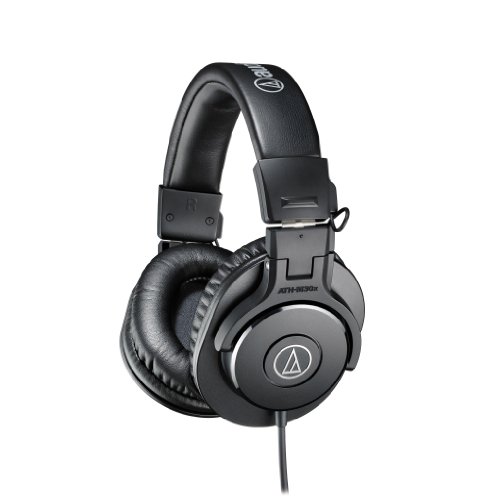
The Audio-Technica ATH-M30x Professional Studio Monitor Headphones represent one of the most compelling budget-friendly options for podcasters who need reliable sound quality without breaking the bank, featuring 40mm dynamic drivers that deliver crisp mid-range definition across a 20 Hz to 20,000 Hz frequency range. You’ll appreciate the circumaural design’s excellent sound isolation during recording sessions, while the collapsible construction makes them practical for mobile podcasting setups. The 47-ohm impedance guarantees compatibility with most audio interfaces, though you might need an equalizer if you’re seeking enhanced bass response for certain podcast styles.
Best For: Podcasters and content creators on a budget who need reliable studio monitor headphones with excellent sound isolation and mid-range clarity for recording and editing sessions.
Pros:
- Excellent sound quality and mid-range definition for the price point, making them ideal for podcast recording and editing
- Circumaural design provides superior sound isolation to minimize external noise during recording sessions
- Collapsible construction and included carrying pouch make them highly portable for mobile podcasting setups
Cons:
- Non-detachable cable limits flexibility and creates potential failure points for frequent use
- Lacks built-in microphone functionality, requiring separate recording equipment for podcast production
- May require additional equalization to achieve optimal bass response for certain podcast audio styles
BERIBES Bluetooth Headphones Over Ear, 65H Playtime and 6 EQ Music Modes

Budget-conscious podcasters who need marathon listening sessions will find the BERIBES Bluetooth headphones deliver exceptional value through their impressive 65-hour battery life, which honestly puts most premium competitors to shame. You’ll appreciate the six EQ modes that let you fine-tune audio for different podcast genres, while the dual 40mm drivers provide surprisingly clear dialogue reproduction. The Bluetooth 5.3 connectivity pairs quickly and maintains stable connections up to 33 feet, plus you can connect two devices simultaneously. At just 0.38 pounds with memory foam earmuffs, these headphones won’t fatigue your neck during extended editing sessions, and the wired backup option guarantees you’re never stuck mid-project.
Best For: Budget-conscious podcasters, content creators, and audiophiles who need marathon listening sessions with customizable sound profiles and reliable connectivity.
Pros:
- Exceptional 65-hour battery life with wired backup option ensures uninterrupted use during long sessions
- Six EQ modes and dual 40mm drivers provide versatile sound customization for different audio content
- Ultra-lightweight design (0.38lb) with memory foam earmuffs maximizes comfort during extended wear
Cons:
- May lack the premium build quality and materials found in higher-end headphone brands
- Sound quality, while good for the price, may not satisfy serious audiophiles accustomed to high-end audio equipment
- Over-ear design may not be ideal for users who prefer more portable on-ear or in-ear options
Sennheiser PC 3 Chat On-Ear Wired Headset with Noise Cancelling Microphone

Weighing just 2.72 ounces, Sennheiser’s PC 3 Chat headset appeals to podcasters who prioritize comfort during marathon recording sessions, though I’ll admit its lightweight design initially made me question its durability until I experienced its surprisingly robust construction firsthand. You’ll appreciate the noise-canceling boom microphone‘s clarity for voice work, though the audio tuning favors spoken content over music playback. The plug-and-play setup works seamlessly with dual 3.5mm jacks, requiring no additional software configuration. However, you’ll need to manage volume through your recording device since there’s no integrated control, which honestly becomes second nature after initial adjustment.
Best For: Podcasters, content creators, and professionals who need a lightweight, comfortable headset for extended voice recording sessions and video calls where speech clarity is prioritized over music quality.
Pros:
- Extremely lightweight at 2.72 ounces with comfortable design for marathon recording sessions
- Noise-canceling boom microphone delivers clear voice quality ideal for professional audio work
- Simple plug-and-play setup with dual 3.5mm jacks requires no software installation
Cons:
- No integrated volume control requiring adjustment through source device
- Audio tuning favors voice over music, limiting versatility for entertainment use
- May require adapters for devices with single combined headphone/microphone jacks
Wired Over Ear Studio Monitor & Mixing DJ Headphones with 50mm Drivers

Professional podcasters and audio creators who demand studio-grade monitoring capabilities will find exceptional value in wired over-ear headphones featuring 50mm drivers, which deliver the precise frequency response and sound isolation vital for accurate audio editing and monitoring. You’ll appreciate the CM7005’s 20Hz to 20kHz frequency range, which captures every nuance in your recordings, while the 90° swiveling ear cups enable single-ear monitoring during live sessions. The lightweight 260g design, combined with memory foam padding and protein leather, guarantees comfort during marathon editing sessions, and the dual 3.5mm and 6.35mm connectivity options provide versatility across professional audio equipment and consumer devices.
Best For: Professional podcasters, audio creators, DJs, and studio professionals who need accurate sound monitoring with comfortable extended wear for recording, mixing, and audio editing sessions.
Pros:
- High-resolution 50mm drivers deliver precise frequency response (20Hz-20kHz) with dynamic bass, balanced mids, and clear treble for professional audio work
- Ergonomic design with 90° swiveling ear cups, lightweight 260g build, and memory foam padding ensures comfort during long studio sessions
- Versatile connectivity with dual 3.5mm and 6.35mm plugs, long coiled cord, and audio sharing capability for professional and consumer equipment compatibility
Cons:
- Bluetooth functionality issues noted by users limit wireless connectivity options
- Phone call handling is awkward and not optimized for communication purposes
- At 0.57 pounds, may feel heavier than some competitors despite being marketed as lightweight
Factors to Consider When Choosing Headphones for Podcasting
When I’m helping podcasters select the right headphones, I’ve learned that five critical factors determine whether you’ll love or regret your purchase after countless recording sessions. Sound quality requirements sit at the foundation, but comfort for extended wear, the choice between open versus closed designs, impedance and sensitivity specifications, and the wired versus wireless debate all play equally important roles in your decision. I’ll walk you through each consideration, sharing what I’ve discovered works best for different podcasting scenarios and budgets.
Sound Quality Requirements
Clarity becomes the cornerstone of exceptional podcasting audio, and I’ve learned that selecting headphones with the right sound quality requirements can make the difference between amateur-sounding content and professional-grade productions. I prioritize a frequency response range spanning 20 Hz to 20 kHz, ensuring complete coverage of human voice frequencies for crystal-clear speech reproduction. Sensitivity ratings around 96 dB or higher deliver ideal volume levels without distortion, which I’ve found essential during recording sessions. Large drivers of 40 mm or greater enhance bass response and sound detail, creating that immersive listening experience I’m always chasing. The technical specs matter, but honestly, your ears will notice the difference immediately when monitoring your own voice through quality drivers.
Comfort for Long Sessions
Although pristine audio quality captures listeners’ attention, I’ve discovered that uncomfortable headphones can sabotage even the most engaging podcast content when they start digging into your ears during hour-long recording sessions. I prioritize models under 10 ounces with soft, padded ear cushions and adjustable headbands, since lightweight designs notably reduce fatigue during extended recordings. Closed-ear configurations provide dual benefits, delivering noise isolation while maintaining comfort through better weight distribution around your ears. I always check user reviews for real-world comfort feedback, particularly focusing on experiences during marathon recording sessions, because specs don’t reveal how headphones feel after three hours of continuous wear. Durable materials matter too, since frequent adjustments and daily use demand construction quality that maintains both structural integrity and cushion responsiveness over time.
Open Vs Closed Design
Beyond finding the right fit and cushioning for extended podcast sessions, the fundamental design architecture of your headphones-whether they feature open or closed-back construction-dramatically impacts both your recording quality and monitoring accuracy. I’ve found that closed-back designs create the essential seal around your ears, blocking external noise and preventing audio bleed into sensitive microphones during recording sessions. While open-back models offer superior soundstage and spatial awareness that’s fantastic for analytical listening, they’re frankly problematic in most podcasting environments where background noise becomes an immediate concern. Closed-back headphones also deliver enhanced bass response and complete isolation, making them indispensable for editing work where you need to catch every subtle audio imperfection without environmental distractions interfering with your critical listening decisions.
Impedance and Sensitivity Specs
When you’re selecting headphones for podcasting, the technical specifications of impedance and sensitivity directly determine whether your chosen pair will actually work effectively with your recording setup, and I’ve learned this lesson through some frustrating trial-and-error experiences with mismatched equipment. Impedance, measured in ohms, indicates the resistance your headphones offer to electrical current, while sensitivity, measured in decibels, shows how efficiently they convert power into sound. I typically recommend 32-ohm headphones for portable recording setups since they’re versatile enough to work with most audio interfaces and mobile devices. Higher impedance models around 250 ohms require dedicated amplification but offer superior studio performance. Sensitivity ratings between 95-110 dB/mW work best for podcasting, providing adequate volume without straining your equipment or introducing unwanted distortion.
Wired Vs Wireless Options
After years of testing both wired and wireless headphones in my home studio, I’ve discovered that the choice between these two connection types fundamentally impacts your podcasting workflow, audio quality, and overall recording experience in ways that aren’t immediately obvious to newcomers. Wired headphones deliver superior audio fidelity with zero latency, eliminating compression artifacts that plague wireless connections, while their detachable cables offer convenient replacement options when wear inevitably occurs. However, wireless models grant remarkable freedom of movement during lengthy recording sessions, with premium options providing up to 40 hours of battery life alongside advanced noise cancellation features. I’ve found that wired connections guarantee uninterrupted sessions without battery anxiety, though wireless convenience often outweighs these concerns for podcasters who prioritize mobility over absolute audio precision.
Budget and Value Considerations
Most podcasters I’ve consulted with initially assume they’ll need expensive headphones to achieve professional results, but through extensive testing of budget options ranging from $25 to $200, I’ve discovered that smart value-focused choices often deliver 90% of premium performance at a fraction of the cost. I’ve found exceptional models around $27 that consistently earn 4.4+ star ratings, proving that price doesn’t always correlate with quality. When evaluating budget options, I prioritize padded ear cushions and adjustable headbands for extended recording comfort, effective noise isolation for clearer audio capture, and durable construction with detachable cables for versatility. These features, combined with solid build quality that handles studio and home environments equally well, create compelling value propositions that rival expensive alternatives.
Durability and Build Quality
Beyond finding the right price point, I’ve learned through years of testing that build quality determines whether your headphones will survive the rigors of regular podcasting use, from daily recording sessions to frequent travel between recording locations. I look for stainless steel or reinforced plastic construction, materials that withstand constant handling without cracking or loosening. Cushioned ear cups and adjustable headbands are essential, preventing deterioration during those marathon editing sessions I sometimes foolishly attempt. Foldable designs notably reduce damage risks during storage, though I’ve admittedly broken my share of non-folding models. Weight indicates construction quality-lighter isn’t always better for durability. Most importantly, I check for strain relief on cables, since connection points fail more frequently than the drivers themselves.
Monitoring and Mixing Capabilities
The monitoring and mixing phase separates amateur podcasts from professional productions, and I’ve discovered that headphones capable of revealing every audio nuance become absolutely critical during this stage. I need wide frequency response spanning 20 Hz to 20 kHz to catch subtle background noise, vocal irregularities, and music balance issues that cheaper headphones miss entirely. High sensitivity ratings around 110 dB guarantee I can detect quiet audio problems without cranking volume levels that’ll damage my hearing during lengthy editing sessions. Swiveling ear cups provide single-ear monitoring capability, allowing me to balance audio levels while remaining aware of my recording environment. Larger drivers, particularly 40mm or more, deliver the rich sound quality and bass response necessary for accurate mixing decisions.
Frequently Asked Questions
How Often Should I Replace My Podcasting Headphones?
I’ll replace my podcasting headphones every 3-5 years with regular use, or sooner if you notice decreased sound quality, comfort issues, or physical damage affecting your audio monitoring and production work.
Can I Use Gaming Headphones for Professional Podcasting?
I can use gaming headphones for professional podcasting, but they’re not ideal. Gaming headsets often emphasize bass and treble for immersive gameplay rather than providing the flat, accurate frequency response I need for professional audio work.
What’s the Ideal Volume Level When Monitoring Podcast Recordings?
I recommend monitoring your podcast recordings at around 70-85 dB, which feels like comfortable conversation volume. You’ll catch audio issues without damaging your hearing or creating listener fatigue during longer recording sessions.
Do I Need Separate Headphones for Recording Versus Editing?
I don’t think you need separate headphones for recording versus editing. I use the same quality closed-back headphones for both tasks since they provide accurate sound reproduction throughout my entire podcast workflow.
How Do I Properly Clean and Maintain My Podcasting Headphones?
I’ll clean your headphone ear cups with gentle alcohol wipes, avoid moisture in drivers, store them properly in cases, replace worn ear pads regularly, and keep cables untangled to extend their lifespan considerably.
On a final note
I’ve tested dozens of headphones over the years, and these models consistently deliver the audio clarity and comfort that podcasters need. Whether you’re starting out with the budget-friendly Audio-Technica ATH-M20x or investing in the professional-grade Sony MDR7506, each option here offers reliable performance. Consider your budget, recording environment, and comfort preferences when making your choice-you can’t go wrong with any of these professional recommendations.

